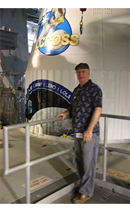Dynamic Response of the Environment At the Moon
 |
Harlan Spence
1. What is your role on the DREAM team?
I will provide observational and modeling expertise of the charged particle environment of the Moon and its interactions with the lunar surface, both while the Moon is in Earth's magnetotail and in the solar wind. As co-Investigator of NASA's LWS EMM-REM Earth-Moon-Mars Radiation Environment Module project (EMM-REM, http://www.bu.edu/csp/EMMREM/) and as a member of the NSF-funded Center or Integrated Space weather Modeling (CISM, http://cism.bu.edu/), I will use existing physics-based models (global MHD and particle) to predict the charged particle environment at the Moon over a range of conditions. The EMM-REM and CISM models will be used in DREAM to explore interactions of these particle populations with the lunar surface, including: (1) contributions to the lunar exosphere from solar wind and Earth's magnetotail plasma sources (c.f., Wilson, Mendillo and Spence, JGR, 2006); (2) access of energetic charged particles to the lunar surface (c.f., Huang, Spence, and Kress, GRL, 2008), especially during events; and (3) activated regolith and secondary radiation produced through cosmic ray surface spallation and with lofted dust, both as a means to assess the lunar radiation environment and also as a means to infer indirectly dust/surface properties.
2. What about DREAM do you find most interesting? Most challenging?
The most interesting and challenging aspect of DREAM are one and the same: the opportunity to part of a highly diverse, interdisciplinary team. The science to be accomplished includes a wide array of scientists with varied interests. DREAM marries these talents to approach an unusual problem that couples together lunar science and space physics in a new way.
3. What other NASA programs or missions have you participated in?
I have been involved with many past NASA missions, including the NASA Polar satellite, to name one. I am currently the PI of the cosmic ray instrument on the NASA Lunar Reconnaissance Orbiter mission, I am PI of a suite of particle instruments on the NASA Radiation Belt Storm Probes mission, and I'm a co-Investigator on the NASA Magnetospheric Multiscale Mission.
4. What kind/level of education do you have?
I have a bachelors degree jointly in Astronomy and Physics (with a minor in mathematics), and Masters and PhD degrees in Earth and Space Science.
5. What advice do you have for students who want to work for NASA or on NASA-related research?
Pursue degrees focusing on any number of areas of science, technology, engineering, and/or mathematics.
6. What are your favorite things to do outside of work?
Play trumpet and sing in musical groups.

